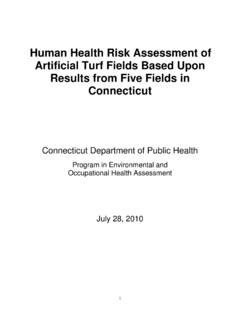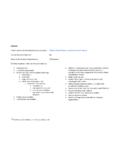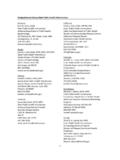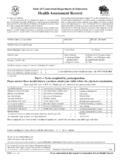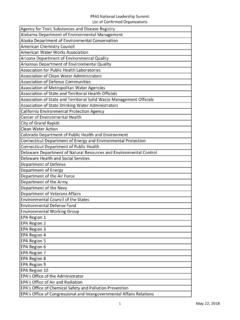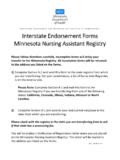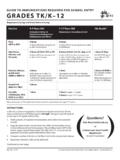Transcription of The Physical School Environment - World Health …
1 The World Health organization sINFORMATION SERIES ON School HEALTHDOCUMENT 2 The Physical SchoolEnvironmentAn Essential Component of a Health -Promoting SchoolThis document is a joint effort of the Department of Protection of theHuman Environment and the Department of Noncommunicable DiseasePrevention and Health is jointly published with partner organizations working together in theinternational initiative to Focus Resources on Effective School Health (FRESH). It is also intended to support the objectives of the HealthyEnvironments for Children principles and policies of each of the above agencies are governed by the relevant decisions of itsgoverning body and each agency implements the interventions described in this document in accordance with these principles and policies and within the scope of its BANKWHOUNICEFiiCONTENTSWHO INFORMATION SERIES ON School Health Why did WHO prepare this document?
2 Who should read this document?.. What is a healthy Physical School Environment ?.. Why increase efforts to improve the Physical Environment at schools?.. Why focus efforts through schools?.. How will this document help people recognize threats and take control over and improve their Environment ?..42. CONVINCING OTHERS THAT SCHOOLS Physical Environment IS Argument: Many childhood illnesses and deaths are greatly influenced by the Respiratory Diarrhoeal diseases .. Vector-borne diseases .. Injuries and Cancer .. Developmental disabilities .. Asthma .. Argument: Children are more susceptible to environmental diseases than adults and therefore need healthy School Water and Indoor air pollutants .. Outdoor air pollutants .. Ultraviolet radiation .. Pesticides .. Food .. Hazardous location .. Argument: Implementing changes in the School s Physical Environment can improve children s CONVINCING OTHERS THAT IMPROVING THE Physical School Environment WILL PROTECT Argument: Children s Health can improve with low-cost interventions to the Physical Environment at Argument: Improvements in the Physical Environment at schools canincrease School Physical School Environment : AN ESSENTIAL ELEMENT OF A Health -PROMOTING SCHOOL4.
3 PLANNING INTERVENTIONS FOR Health PROTECTION IN School Procedural steps toward creating a healthy Physical Environment at Goals Substantive goals .. Procedural goals .. Participation in planning the Form a School Health team .. Establish a community advisory committee .. Intervention Identify information needs .. Answer basic questions and identify key information sources .. Commitment and Gain national political commitment .. Achieve community commitment ..255. INTEGRATING ENVIRONMENTAL Health INTERVENTIONS WITHINVARIOUS COMPONENTS OF A Health -PROMOTING Skills-based Health Methods and materials for skills-based Health education in relation to the Environment .. Training teachers to implement skills-based Health education in relation to the Environment .. The student s role in skills-based Health education in relation to the Environment .. A healthy School A safe School location and structure.
4 Indoor School Outdoor School Environment .. Healthy environmental management practices .. School Health Community and family projects and Health promotion for School Components of Reporting progress and 1: EXAMPLES OF EDUCATIONAL STRATEGIES TO PROMOTE ENVIRONMENTAL INFORMATION SERIES ON School Health This document was prepared for the World Health organization (WHO) by John Wargo, YaleUniversity, New Haven A. Rehfuess, Department of Protection of the Human Environment , WHO, and Jack and Charles W. Gollmar, Department of Noncommunicable Disease Prevention andHealth Promotion, WHO guided the overall development and completion of this editing was undertaken by Martha Shimkin, and Caron Gibson, and copy editingby Karina paper draws on a variety of sources in the research literature and on consultation withexperts working in the area of School Health and environmental Health .
5 We wish to thankthe following organizations and persons for their technical guidance, inspiration and generosity: Monika Arora, HRIDAY-SHAN, IndiaMarie Louise Bistrup, International Research and Information Network on Children s Health , Environment and SafetyAmaya Gillespie, Senior Advisor, Education Sector, UNICEFJose Hueb, Protection of the Human Environment , WHOR ichard Helmer, Protection of the Human Environment , WHOKate Joicey, Gesellschaft f r Technische Zusammenarbeit, IndonesiaJenny Pronczuk, Protection of the Human Environment , WHOY asmin von Schirnding, Healthy Environments for Children Alliance, WHOM erri Weinger, Environmental Health Technical Advisor, USAIDN ational Council on Education, UruguayvFOREWORDTHE Physical School Environment : AN ESSENTIAL ELEMENT OF A Health -PROMOTING School The children of today are the adults of tomorrow. They deserve to inherit a safer and healthier World .
6 There is no task more important than safeguarding their Environment . Thismessage is emphasized by the Healthy Environments for Children Alliance (HECA), whichfocuses attention on the School Environment as one of the key settings for promoting children s environmental Health . HECA was launched at the 2002 World Summit onSustainable Development. This publication is intended as a tool to help schools shapehealthy environments for Physical School Environment : An Essential Component of a Health -Promoting Schoolfocuses on the Physical Environment of the School and is complemented by the documentCreating an Environment for Social and Emotional Well-being: An Important Responsibilityof a Health -Promoting and Child-Friendly School . Together, these two resources can helpschools provide an Environment that is supportive of the World Health organization s definition of Health .
7 A state of complete Physical , mental and social well-being and notmerely the absence of disease or infirmity . The Physical School Environment : An Essential Component of a Health -Promoting Schoolincludes information to create a healthy School Environment , and to identify and modifyaspects of the Physical Environment that jeopardize safety and Health . However, physicalinterventions alone will not suffice. The document also contains guidance to ensure thatpositive changes in a School s Physical Environment are supported, reinforced and sustainedby School Health policy, skills-based Health education and School Health services, the corecomponents of an effective School Health programme as called for in the international initiative to Focus Resources on Effective School Health (FRESH). The extent to which each nation s schools provide a safe and healthy Physical environmentplays a significant role in determining whether the next generation is educated and School Health programmes, including a safe and healthy School Environment , areviable means to simultaneously address the inseparable goals of Health for All andEducation for All.
8 Pekka PuskaDirector, Noncommunicable DiseasePrevention and Health PromotionWHO, Geneva, SWITZERLANDMary Joy PigozziDirector, Division for the Promotion of Quality EducationUNESCO, Paris, FRANCEC heryl Vince-WhitmanDirector, WHO Collaborating Center toPromote Health through Schools andCommunitiesEducation Development Center, , Massachusets, USAFred Van LeeuwenGeneral SecretaryEducation InternationalBrussels, BELGIUMC ream WrightChief, Education SectionUNICEF, New York, USAL eslie DrakeCoordinator, Partnership for ChildDevelopmentLondon, UNITED KINGDOMM aged YounesSenior Advisor, Health andEnvironment Coordinator,Occupational and EnvironmentalHealth,WHO, Geneva, SWITZERLAND11. INTRODUCTIONWHO INFORMATION SERIES ON School Health 1. IntroductionEnvironmental challenges and opportunities vary considerably among schools around theworld, across countries and within communities.
9 Similarly, the resources available to schoolsto manage Health hazards vary as widely as the threats themselves, often creating formidable management challenges, particularly in the poorest parts of the from recommendations of the Ottawa Charter for Health Promotion, The PhysicalSchool Environment : An Essential Component of a Health -Promoting Schooldiscusses arange of environmental conditions that exist in a variety of School environments. It presentsstrategies to improve the Health , education and development of children, families, and community members and aims to help communities recognize, manage, and avoid Physical , chemical and biological threats that may exist in or near their schools. 1 Why did WHO prepare this document?The World Health organization (WHO) prepared this document to help individuals, communities, School officials, and governments improve the Health of children by reducing their exposure to environmental hazards.
10 This will be accomplished by providinginformation to help people understand the relationship between the Environment andhealth, identify key hazards in the places where children learn, and recognize children sspecial vulnerability and exposure to environmental threats. By taking action, Health -promoting schools will send messages home to families and communities, encouragingawareness, and building skills to last a lifetime so that protecting children from environmental hazards becomes a way of Who should read this document?This document can be useful to: Members of the School community, including teachers and their representativeorganizations, administrative staff, students, parents, School facility managers, andschool construction workers. Community leaders, local residents, Health care providers, and other groups interested in improving public Health .










